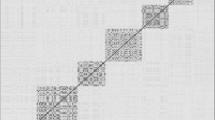Abstract
Apomixis, or asexual reproduction through seeds, occurs in over 400 species of angiosperms. Although apomixis can favorably perpetuate desired genotypes through successive seed generation, it may also bring about some difficulty for linkage analysis and quantitative trait locus mapping. In this article, we explore the issue of how apomixis affects the precision and power of linkage analysis with molecular markers. We derive a statistical model for estimating the linkage between different markers when some progeny are derived from apomixis. The model was constructed within the maximum likelihood framework and implemented with the EM algorithm. A series of procedures are formulated to test the linkage of markers, the rate of apomixis, and the degree of genetic interference during meiosis. The model was examined and validated through simulation studies. The model will provide a tool for linkage mapping and evolutionary studies for plant species that undergo apomixis.



Similar content being viewed by others
References
Bicknell RA, Koltunow AM (2004) Understanding apomixis: recent advances and remaining conundrums. Plant Cell 16:S228–S245
d’Erfurth I, Jolivet S, Froger N, Catrice O, Novatchkova M et al (2009) Turning meiosis into mitosis. PLoS Biol 7(6):e1000124
Grattapaglia D, Sederoff R (1994) Genetic linkage maps of Eucalyptus grandis and E. urophylla using a pseudo-testcross mapping strategy and RAPD markers. Genetics 137:1121–1137
Grimanelli D, Leblanc O, Espinosa E, Perotti E, Gonzlez de Leon D, Savidan Y (1998) Mapping diplosporous apomixis in tetraploid Tripsacum: one gene or several genes? Heredity 80:33–39
Grimanelli D, Leblanc O, Perotti E, Grossniklaus U (2001) Developmental genetics of gametophytic apomixis. Trends Genet 17:597–604
Hanna WW (1995) Use of apomixis in cultivar development. Adv Agron 54:333–354
Koltunow AM (1993) Apomixis: embryo sacs and embryos formed without meiosis or fertilization in ovules. Plant Cell 5:1425–1437
Koltunow AM, Grossniklaus U (2003) Apomixis: a developmental perspective. Annu Rev Plant Biol 54:547–574
Lathrop GM, Lalouel JM, Julier C, Ott J (1984) Strategies for multilocus linkage analysis in humans. Proc Natl Acad Sci USA 81:3443–3446
Lu Q, Cui YH, Wu RL (2004) A multilocus likelihood approach to joint modeling of linkage, parental diplotype and gene order in a full-sib family. BMC Genetics 5:20
Ozias-Akins P (2006) Apomixis: developmental characteristics and genetics. Crit Rev Plant Sci 25:199–214
Ozias-Akins P, van Dijk PJ (2007) Mendelian genetics of apomixis in plants. Annu Rev Genet 41:509–537
Ozias-Akins P, Roche D, Hanna WW (1998) Tight clustering and hemizygosity of apomixis-linked molecular markers in Pennisetum squamulatum implies genetic control of apospory by a divergent locus that may have no allelic form in sexual genotypes. Proc Natl Acad Sci USA 95:5127–32
Richards AJ (2003) Apomixis in flowering plants: an overview. Philos Trans R Soc Lond B Biol Sci 358:1085–1093
Spielman M, Vinkenoog R, Scott RJ (2003) Genetic mechanisms of apomixis. Philos Trans R Soc Lond B Biol Sci 358:1095–1103
Spillane C, Steimer A, Grossniklaus U (2001) Apomixis in agriculture: the quest for clonal seeds. Sex Plant Reprod 14:179–187
Spillane C, Curtis MD, Grossniklaus U (2004) Apomixis technology development-virgin births in farmers’ fields? Nat Biotechnol 22:687–691
Wu RL, Ma CX, Casella G (2007) Statistical genetics of quantitative traits: linkage, maps, and QTL. Springer, New York
Acknowledgments
This work is partially supported by an Open Fund 200602 from former Zhejiang Forestry University, a grant 30771752 from the NSF of China, NSF/IOS-0923975, Changjiang Scholars Award, and “Thousand-person Plan” Award.
Author information
Authors and Affiliations
Corresponding authors
Additional information
Communicated by M. Sillanpaa.
W. Hou and S. Lin contributed equally to this work.
Rights and permissions
About this article
Cite this article
Hou, W., Lin, S., Li, Y. et al. A model for linkage analysis with apomixis. Theor Appl Genet 123, 681–691 (2011). https://doi.org/10.1007/s00122-011-1618-4
Received:
Accepted:
Published:
Issue Date:
DOI: https://doi.org/10.1007/s00122-011-1618-4




